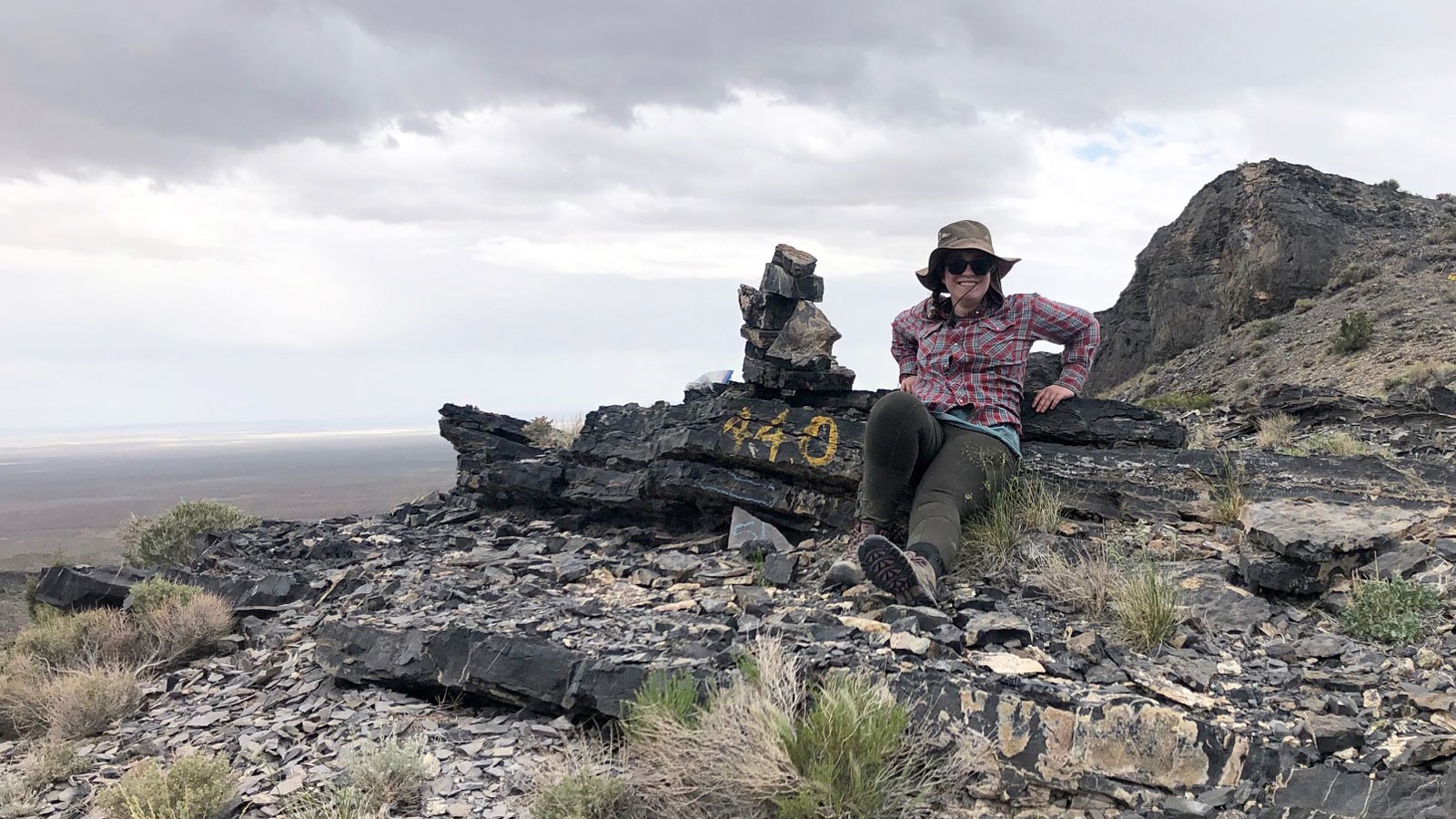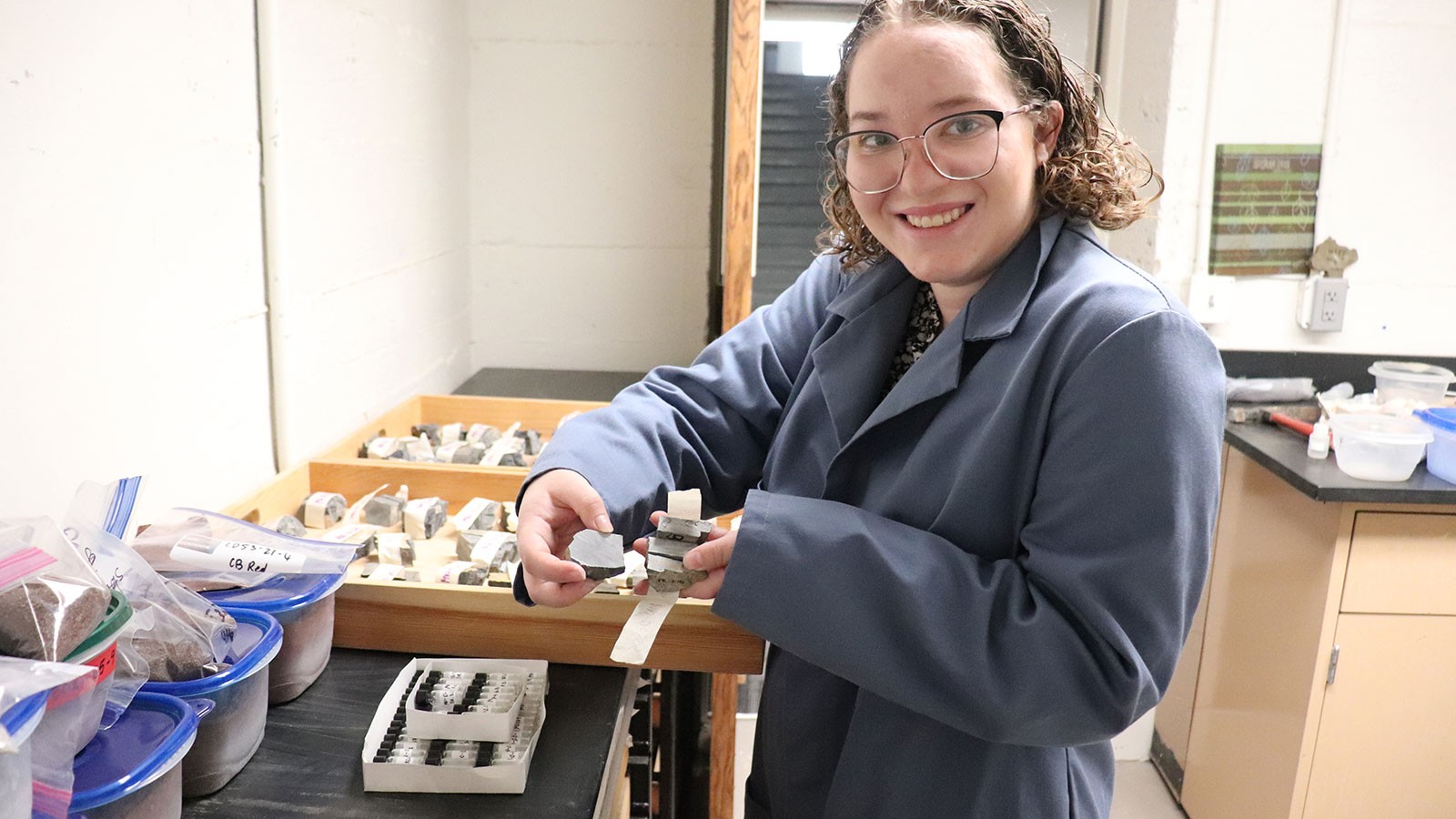USU Undergraduate Geologist Deciphers Ancient Questions in Utah's Drum Mountains
Honors scholar Michelle Norman was among Aggies sharing research with state legislators Jan. 20 on Utah's Capitol Hill.
By Mary-Ann Muffoletto |
At a field research site near Delta, Utah, USU Honors scholar Michelle Norman pauses during a three-day trip to study a section of the Great Basin Drumian Carbon Isotope Excursion (DICE) in the Drum Mountains. (Photo Credit: Carol Dehler/USU)
At Undergraduate Research Day 2023 on Utah’s Capitol Hill, Utah State University Honors scholar Michelle Norman discovered Rep. Doug Owens, D-Millcreek, is a fellow geology enthusiast.
“I had a really fun conversation with him about the geology of Utah’s Delta area,” Norman says. “He spends time there rock hounding, and he invited me onto the House floor, while representatives were in session, to take a look at some cool nautiloid fossils in the walls of the House chamber. It was really neat.”
Norman, who is majoring in geology with a minor in mathematics, was among about 50 USU and University of Utah undergraduate researchers invited to participate in the annual event on Jan. 20. Initiated in 2000, the gathering, conducted each year during the state’s busy legislative session, highlights the importance of research in higher education and to the Utah residents.
Norman pursued field work in Utah’s west-central desert, near the Millard County town of Delta, where the Drum Mountains stand as steadfast sentinels of history ranging from their origin some 500 million years ago during the Cambrian Period. Remnants of the period, in the form of trilobite fossils — evidence of an unparalleled emergence of animal life aptly named the “Cambrian Explosion” — are abundant in the arid landscape.
To the delight of school children viewing the college scholars’ research posters in the Capitol Rotunda, Norman passed around trilobite fossils and limestone samples they collected during a September 2021 fieldwork trip with USU Geosciences professor Carol Dehler and graduate student Hannah Cothren.
Norman and their mentors study the Great Basin Drumian Carbon Isotope Excursion (DICE) at the Drumian Global boundary Stratotype Section and Point (GSSP) above the base of the Wheeler Formation in the Drum Mountains, about 24 miles northwest of Delta.
Getting to the remote and rugged research site was challenge, as the team lost GPS service.
“We navigated our way on a sketchy, unmapped dirt road, which delayed our arrival,” Norman says. “We expected hot, dusty, gross weather. Instead, it was cold, windy and rainy.”
Undaunted, the team pitched tents and spent three days measuring an 81.5-meter section of the excursion, which is a geochemical feature hypothesized to be caused by a dramatic geological event associated with a rise in sea level during the Cambrian Period.
“We began our work early each day, carefully measuring and describing rock units in a stratigraphic column — ‘shale here, limestone here, trilobites here’ — as we made our way upward,” Norman says. “We collected a lot of freaking rock samples.”
The researchers carried those rocks in 5-gallon buckets and transported them back to campus for analysis.
In the Department of Geosciences labs, Norman has painstakingly studied the geochemistry of the rock samples, and compiled and analyzed data to better understand the behavior of the DICE. Among graduate students and seasoned professionals, they presented their findings at the Fall 2022 Geological Society of America Annual Meeting in Denver.
“Michelle’s presentation was impressive and well received,” says Dehler, professor and undergraduate mentor in the Department of Geosciences.
Norman, who was awarded a College of Science Undergraduate Research Minigrant to pursue the project, says they like research because “I’m not being graded for not knowing the answers.”
“No one knows the answers and we’re always searching,” they say. “That’s science. You’re always going back to the drawing board. It’s hard, but also really cool. And it’s not just about rocks. You’re thinking about systems — earth sciences, animal life and climate — I like it.”
As for conducting research in middle-of-nowhere western Utah, near the site of the former Topaz internment camp where Japanese Americans were forcibly taken during World War II, Norman says the landscape is beautiful, yet desolate.
“For me, studying what I love, the area is breathtaking, but it’s hard to imagine what those people endured,” says the Undergraduate Research Fellow, who toured the camp’s remains and the museum with their family some years ago. “It’s sobering to acknowledge and to imagine being forced to live in such a barren place with the uncertainty of not knowing when you could go home.”
In a Department of Geosciences lab, Norman analyzes the geochemistry of collected rock samples. The Undergraduate Research Fellow was awarded a College of Science Minigrant to pursue their project. (Photo Credit: M. Muffoletto/USU)
WRITER
Mary-Ann Muffoletto
Public Relations Specialist
College of Science
435-797-3517
maryann.muffoletto@usu.edu
TOPICS
Research 877stories Undergraduate Research 156stories Geosciences 74storiesComments and questions regarding this article may be directed to the contact person listed on this page.









